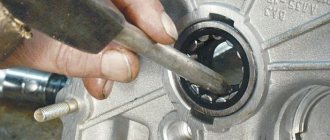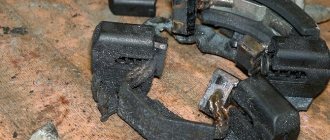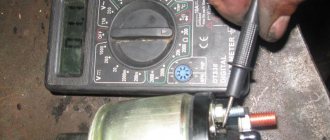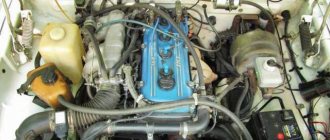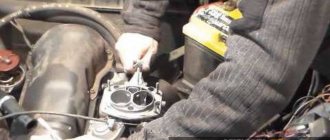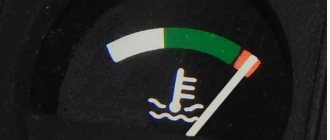Dima Kashevsky [kashevsky_dima]
04.10.2020,
I often encountered a problem when a VAZ would not start. Owners of injection and carburetor cars contacted us. Below I will list common causes that should help with your problem. Before that, it’s only worth saying that below we will talk about both old and new models. The material is voluminous, because I decided to describe everything in detail.
There are three main reasons why a domestic car does not want to start:
- Lack of fuel in the combustion chamber
- Lack of oxygen
- No ignition
As a rule, 80 percent of malfunctions lie in these three reasons. Let's take a closer look.
Ignition problems
The most common malfunction. The spark itself may exist, but its strength is not sufficient to ignite the fuel mixture. To identify the problem, the first step is to check the spark plugs.
In case anyone doesn't know, spark plugs can be found by the wide wires coming from them. We need to determine which candle has failed, because they cannot all break at once. To check, you need to start the VAZ engine and listen to the sound of its operation. Next, we unscrew the spark plugs one by one and listen to how the sound of the engine changes. When you remove a faulty spark plug, the sound of the engine will not change.
Inspect the unscrewed spark plug. By the carbon deposits on it you can determine why it failed. Most likely, the electrode will have one of the following deposits:
- Of red color. Occurs due to the addition of various additives to car fuel. If you see this type of carbon deposits, then you should refuse additives, because soon you will have to change the remaining spark plugs.
- White (similar to plaque). Indicates that the fuel mixture is unbalanced. This means that it is formed in the wrong oxygen/fuel ratio. There may be either an excess of fuel or an excess of oxygen.
- Matt black color. Occurs due to an excess of gasoline in the fuel mixture. Reason: the carburetor is incorrectly adjusted or the injector is not working correctly. Another symptom: increased fuel consumption.
- Oil black. Logically, this indicates increased oil consumption, which gets onto the electrode and interferes with the formation of a spark.
It is important to know! The spark plugs may be outwardly in good working order and the lack of a spark may be caused by filling the spark plug electrode with gasoline. This occurs due to a low battery charge.
Candles
Spark plugs are the next most likely cause of a failure to start the engine. After repeated attempts to start, they simply drown in fuel, as drivers say: the spark plugs are flooded.
Experienced car enthusiasts recommend that in such a situation, press the gas pedal to the floor and turn on the ignition
, after such manipulation the spark plugs dry out and begin to produce a normal spark.
Faulty starter
The problem with the starter on VAZs is very relevant. According to statistics, before a major overhaul of the engine, there is a need to repair the starter at least once. After checking the spark plugs, I advise you to pay attention to this mechanism and most likely the fault will lie there.
To determine the problem, you need to determine what type it is:
- Electric
- Mechanical
It is very easy to determine: if the starter does not turn and the VAZ does not start, then the problem is in the electrics. If you hear it spinning, then there is a mechanical problem. Let's figure out what can break down in the starter's electrics and what can go wrong in the mechanics.
Checking the contact.
Start checking with the simplest thing: inspecting the terminals on the mechanism body. Due to our “great” weather conditions, they like to oxidize, causing contact to be lost. As a result, the control impulse does not reach the motor and when we turn the ignition key we hear nothing. To clean the terminals, a regular fine knife or natfel will do.
Advice: to avoid corrosion of the terminals, you should treat them with lithol. It is first necessary to clean off any pockets of corrosion.
During the test, you will be able to confirm that there is no open circuit: each wire should be fixed to the starter terminals. Without diagrams on all VAZ models, the connection is similar:
- One “plus” from the battery goes to the starter terminal
- The second “plus” comes from the ignition switch through the fuse box
Check the fuse box, as a blown fuse breaks the circuit and no control voltage is supplied to the starter. Just visually check the fuse and if you see that it has burned out, replace it.
Checking the serviceability of the retractor
relay. This device is responsible for extending the bendix. Diagnosing a malfunction of the solenoid relay is easy, since it operates with a characteristic clicking sound.
A clicking sound appears when you turn the ignition key. If the solenoid relay does not click, then the problem lies with it or its fuse. Unfortunately, this part cannot be repaired, but it is inexpensive. By the way, there is a simple trick that often helps to revive a broken solenoid relay: you just tap it lightly with a hammer several times. In most cases this method works.
Broken Bendix gear teeth.
This is a rather rare type of reason why a VAZ will not start, but it is very easy to diagnose: an unpleasant metallic grinding sound will be heard from under the hood after turning the ignition key.
The problem is resolved by replacing the starter.
Another common reason why the starter does not turn and the VAZ does not start: a blown starter fuse. In this case, the solenoid relay does not click.
Popping sound when starting the VAZ 2106 engine
Popping noises when starting the engine is another unpleasant phenomenon that sooner or later every owner of a “six” encounters. Moreover, the car can “shoot” both at the muffler and at the carburetor. Let's consider these points in more detail.
Popping sounds in the muffler
If the “six” “shoots” at the muffler when starting the engine, it means that the gasoline entering the combustion chambers has completely flooded the spark plugs. Fixing the problem is quite simple: you need to remove the excess fuel mixture from the combustion chambers. To do this, when starting the engine, press the gas pedal all the way. This will ensure that the combustion chambers are quickly purged and the engine will start without unnecessary pops.
The photo clearly shows that the contact part of the spark plug is completely filled with the fuel mixture
More information about the VAZ 2106 muffler: https://bumper.guru/klassicheskie-modeli-vaz/dvigatel/glushitel-vaz-2106.html
The problem is especially relevant in winter, when starting “cold”. After a long period of inactivity, the engine needs to warm up properly, and it does not need a too rich fuel mixture. If the driver forgets about this simple circumstance and does not reset the choke, then the spark plugs are flooded and popping noises inevitably occur in the muffler.
I will tell you one case that I personally witnessed. It was winter, thirty degrees below zero. A neighbor's guy in the yard was unsuccessfully trying to start his old carburetor "six". The car started, the engine ran for literally five seconds, then stalled. And so several times in a row. In the end, I recommended that he remove the choke, open the gas and try to start. The question followed: it’s winter, how can you start it without suction? He explained: you’ve already pumped too much gasoline into the cylinders, now you need to blow them out properly, otherwise you won’t go anywhere until the evening. Ultimately, the man decided to listen to me: he removed the choke, squeezed the gas all the way, and started starting. After a couple of turns of the starter, the engine started. After which I recommended that he pull out the choke a little, but not completely, and reduce it as the engine warms up. As a result, the engine warmed up properly and after about eight minutes it started working normally.
Popping sounds in the carburetor
If, when the engine starts, popping sounds are heard not in the muffler, but in the carburetor of the VAZ 2106, then this indicates that the choke is not working properly. That is, the working mixture entering the combustion chambers of the cylinders is too lean. Most often the problem occurs due to too much clearance in the carburetor choke.
When the starting gap increases, popping noises occur on the valve in the carburetor.
This damper is actuated by a special spring-loaded rod. The spring on the rod may weaken or simply fly off. As a result, the damper stops tightly closing the diffuser, which leads to a leaner fuel mixture and subsequent “shooting” in the carburetor. It is not difficult to find out that the problem is in the damper: just unscrew a couple of bolts, remove the air filter cover and look into the carburetor. To understand that the air damper is well spring-loaded, just press it with your finger and release it. After this, it should quickly return to its original position, completely blocking the access of air. There should be no gaps left. If the damper does not adhere tightly to the walls of the carburetor, then it is time to change the damper spring (and you will have to change it along with the rod, since these parts are not sold separately).
Video: cold start of a VAZ 2106 engine
So, there are a great many reasons why the “six” may refuse to start. It is not possible to list them all in one short article, but we have analyzed the most common reasons. The vast majority of problems that prevent the engine from starting normally can be resolved by the driver himself. To do this, you need to have at least a basic understanding of the operation of the carburetor internal combustion engine installed on the VAZ 2106. The only exception is the case with reduced compression in the cylinders. To fix this problem, unfortunately, you cannot do without the help of qualified auto mechanics.
Fuel pump malfunction
With this malfunction, the Zhiguli engine starts, and then stalls or does not start at all. The first step is to check whether the fuel pump fuse is working properly, because according to statistics, 60 percent of VAZ fuel pump failures are associated with a blown fuse. In VAZ 2105 it is located in a block under the hood near the windshield, in VAZ 2107, 2109, 2115 in the cabin below the dashboard. In VAZ 2110, 2111 and 2112 it is located in the cabin in the place of the front passenger's feet. Next to the fuses there are relays, which are also responsible for the operation of the fuel pump. If the fault is not in the fuse or relay, then it lies either in the fuel pump itself or in its power supply circuit.
In carburetor VAZs, the fuel pump is located in the engine compartment next to the cylinder head.
All “classics” such as the Zhiguli were equipped with a fuel pump called DAAZ. Its catalog number is: 1106010. The part is very reliable, so the likelihood that the problem is with it is not high. And even if it breaks, you can buy repair kits.
In injection VAZs with a fuel pump, everything is not so fabulous.
It is hidden in the gas tank and likes to fail if there is little fuel inside. The pump motor is electric and is cooled by the gasoline itself, in which it is located. If there is little gasoline, the pump does not cool well, overheats and eventually breaks down.
The car may have difficulty starting due to low fuel content in the tank.
Injectors
Due to the “high-quality” domestic fuel, injectors tend to become clogged with slag more often than is provided for by the standards for their uninterrupted operation. Checking them is as simple as checking for the presence of a spark in the candles. If you just attach the spark plugs to the engine body and turn the starter to see the presence or absence of a spark, then you can check the injector using the same principle.
Crankshaft position sensor
The sensor itself is very reliable, and there is nothing to break there. However, it can become clogged with a thick layer of dirt and stop functioning. The way out of the situation is simple: just wipe it. As a rule, it cannot become dirty immediately and the problem will manifest itself gradually: at first your VAZ does not start well, and after a month the car is no longer able to start.
Since a lot of dirt accumulates on this sensor, its contact with the wire simply rots. This is already a common problem, but it can be easily solved by manually restoring contact. The crankshaft sensor is located on the oil pump.
It is important to know! It is not permissible to make contact using twists. So you will lose it in a month, so it is best to solder the contact and cover it with lithol.
Checking injectors and timing belt
When there is a spark and its color is bright bluish, check the fuel supply: turn out the injectors and turn the engine shaft with the starter. The fuel should be sprayed from the nozzle in a uniform cone-shaped “torch”. If instead the injector pours gasoline or splashes it, then it is clogged.
If the tested components are working, then look at the timing belt. Owners of the injection “nine” have more than once encountered the situation of the belt slipping by several teeth. In winter, this can happen when starting a cold engine when the camshaft rotates heavily. To check, look at the timing mark. If it matches, check the crankshaft sensor and its wire (sometimes it comes off). Then the remaining sensors are checked.
VAZ starts and immediately stalls
The car may stall immediately after starting, even due to trivial little things such as consumables. Therefore, first of all, I advise you to check the fuel and air filters. If they are clogged, it is difficult for the engine to receive oxygen and fuel, which causes it to simply stall.
If before your VAZ stopped starting, the following were discovered:
- Power Loss
- The car doesn't start well
- Increased fuel consumption
It is most likely that the catalyst that is equipped with VAZ injection models is faulty. The catalyst can be removed by flashing the engine control unit. As an alternative: install lambda decoys. A clogged catalyst may also be the reason why the VAZ does not start.
Diagnostics of contactless ignition system
Sometimes the VAZ 2109 does not start the first time.
The reason for this may probably be located in the ignition system. In recent years, cars have been equipped with a contactless system. Checking this system does not require any special tools. Everything can be purchased at your nearest auto supply store.
It is more rational to carry out diagnostics of the MD-1 sensor. It is connected to the place of the switch. Next, turn on the ignition.
Working with the sensor is very simple. It has three indicators:
- “P” – indicates the proper functioning of the ignition switch;
- “K” – shows the state of the primary winding;
- “D” – shows the proper operation of the hall sensors when the starter is turned on.
If all indicators work, then there are no malfunctions.
Fuel system problems
Among the elements of the fuel system, the following factors influence engine starting:
Also included in this category are electrical components that are directly related to the fuel supply. This is an electric fuel pump and a fuel pump relay.
Before checking other methods, you must be completely sure that the VAZ 2114 with an injector is filled. “Yes, there are still five liters there” according to the indicator on the tidy or “I filled it up yesterday, I couldn’t spend that much” are not suitable. The gauge may be lying, and there may be leaks in the tank or fuel lines. Carefully check the car for fuel leaks; just in case, fill in 5-7 liters of gasoline from a canister.
The mesh in the tank rarely gets clogged, leave this option for last, but it’s worth trying to change the fine filter if electrical problems are ruled out.
The operation of the fuel pump is checked by ear (after turning the key, its operation should be heard; if not, the pump has “died”, or the pump relay, or a wiring break). According to the manual, you need to connect a pressure gauge to the fuel system. If the pressure does not stay within 2-2.5 atm, the VAZ 2114 will not catch due to insufficient fuel pressure.
Injection engine does not start
The injection engine does not start, what should I do?
If it is more or less clear with carburetor engines, what to do if an injection engine does not start? Good for owners of large cities where there are tow trucks and a large number of car services. What about in small towns and villages? Can I find and fix the problem myself? At least you can try. The devil is not as scary as he is painted. What might be needed for this and is it possible to do without special diagnostic equipment? In some cases, and such malfunctions are much more common than serious ones.
The injection engine does not start, which is necessary to troubleshoot.
To find and eliminate most faults, a test lamp, a spark gap and a multimeter are enough. the cost of the latter is approximately 250 - 300 rubles. You can make a test lamp yourself by connecting two wires to the instrument backlight lamp. Under no circumstances use large and powerful lamps, such as headlights, for this purpose. The lamp power should not exceed 2.5-3 W. otherwise the controller may be damaged. You can use LEDs for this purpose, but you must take into account that it is polarized, that is, one of its terminals must be connected only to the plus, and the other to the minus.
The spark gap is needed to check the presence of a spark discharge on the spark plugs. You can do it yourself. A couple of old candles or something else will do.
To check the fuel system, it is better to use a fuel pressure gauge. The monometer must be designed for a pressure of at least 5 atm. You can assemble the connection fittings yourself.
Injection engine does not start, troubleshooting.
If the starter of your car turns normally, but the car does not start, the first thing you need to do is check that the fuel pump is turned on. On domestic cars, its operation can be heard from the passenger compartment; when the ignition is turned on, a characteristic buzzing sound comes from under the rear seat or trunk.
If you cannot hear the fuel pump turn on, you need to check the integrity of the fuses and the activation of the main relay of the engine control system and the fuel pump relay. On the VAZ-2107, VAZ-2108, VAZ-2109 and their modifications, relays and fuses are located on the shelf under the glove compartment or under it. On VAZ-2110, VAZ-1117 and similar ones, you should look in the heater console on the passenger side by unscrewing the fastening screws and removing the side cover.
If the fuses are working properly, check the activation of the main relay and the fuel pump relay. Turning on is determined by a characteristic click, or you can feel it by placing your finger on it.
To determine the malfunction if any of the relays do not turn on, follow the corresponding link by clicking on it with the mouse: MAIN RELAY DOES NOT TURN ON, FUEL PUMP RELAY DOES NOT TURN ON.
Checking the fuel system.
If the fuel pump turns on, check for fuel pressure in the rail. If available, you can use a pressure gauge, but if it is not there, you can most likely check it simply by eye. To check the pressure on VAZ cars, you need to press the spool located at the end of the ramp, on the opposite side from the supply, under the protective cap. Checking the pressure on GAZ vehicles is carried out by disconnecting the supply tube, which is attached to the ramp. When the fuel pump is turned on, the fuel pressure must be at least 2.8 atm.
Reasons why the injection VAZ 2114 does not start
The design of any modern car, the VAZ 2114 is no exception, is such that the successful production of a car depends on a number of positions. Previously, this was enough for the mechanical pump to supply fuel to the carburetor, and for the spark plugs to produce a spark. Today there are a lot of problems that prevent the engine from starting. An electronic injector requires the participation of several sensors, and the matter is not limited to them. In this article we will tell you why not and how to deal with it.
In general, all causes of malfunction can be divided into two large categories:
The most terrible malfunctions can be included in a separate category - for example, a “knocking” VAZ 2114 engine, a broken timing belt and, as a result, bending of the valves. In these situations, expensive repairs cannot be avoided.
